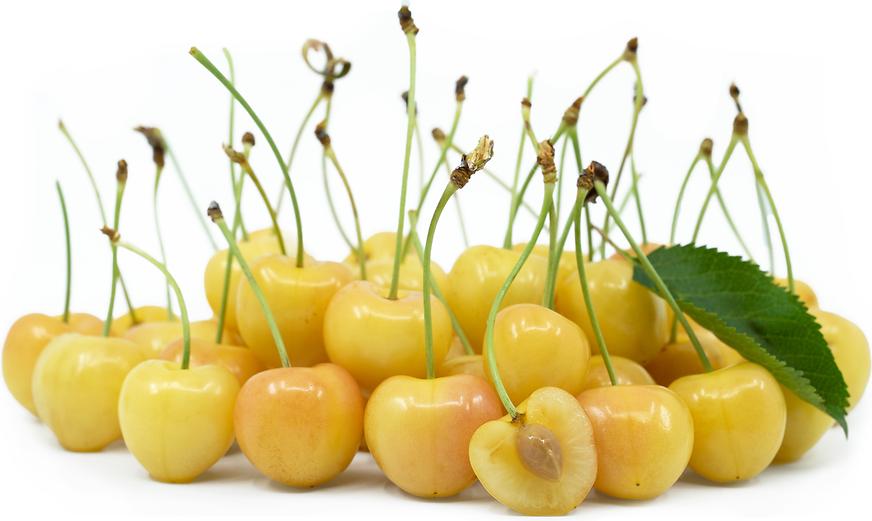


Donnisens Gelbe Knorpelkirsche Cherries
Estimated Inventory, lb : 0
Description/Taste
Donnisens Gelbe Knorpelkirsche cherries are a small to medium-sized varietal, averaging 2 to 2.5 centimeters in diameter, and have a cordate shape with curved shoulders, tapering to a rounded tip. The cherry's skin is smooth, glossy, taut, and semi-thin, showcasing pale yellow hues with faint pink blushing. It is important to note that the skin is delicate and easily bruised, often developing brown spots with excessive handling. The fruits are attached to long and slender green stems extending 4.5 centimeters in length. Underneath the surface, the flesh is yellow, firm, and semi-translucent with a succulent consistency. The flesh also encases a tan, oval, and tapered moderately-sized stone. Donnisens Gelbe Knorpelkirsche cherries have a sweet, initially tangy flavor that dissipates quickly, leaving subtle fruity nuances on the palate.
Seasons/Availability
Donnisens Gelbe Knorpelkirsche cherries are available in the summer, typically ripening in the last week of June or the first week of July.
Current Facts
Donnisens Gelbe Knorpelkirsche cherries, botanically classified as Prunus avium, are a rare variety belonging to the Rosaceae family. The sweet cherry cultivar was developed in Germany in the early 19th century and is a type of yellow cherry valued as an ornamental and culinary variety. Donnisens Gelbe Knorpelkirsche cherries are named after their discoverer, and the descriptor "gelbe" translates to mean "yellow" while "knorpelkirsche" means "cartilage cherry," a term used to describe the fruit's firm flesh. The variety was once one of the most popular yellow cherry cultivars in Germany, but due to its delicate nature, it has not been chosen for commercial production. Donnisens Gelbe Knorpelkirsche cherries are favored for their high yields, and the yellow fruits are ignored by birds, a common pest that can decimate cherry crops. Birds are notorious for eating sweet cherries, especially red ones, but the yellow fruits have the ability to hide within the branches and leaves. In the present day, Donnisens Gelbe Knorpelkirsche cherries are a specialty variety grown among cherry enthusiasts and are a versatile fruit consumed in an array of fresh and cooked preparations.
Nutritional Value
Donnisens Gelbe Knorpelkirsche cherries are a good source of potassium to balance fluid levels within the body and fiber to regulate the digestive tract. The fruits also contain phosphorus to build strong bones and teeth, vitamin A to maintain healthy organ functioning, vitamin C to reduce inflammation, strengthen the immune system, and boost collagen production within the skin, and contain other nutrients including vitamin E, magnesium, vitamin K, copper, and manganese.
Applications
Donnisens Gelbe Knorpelkirsche cherries have a sweet flavor suited for fresh and cooked preparations. The yellow cherries are popularly consumed straight out of hand or tossed into green and fruit salads as a fresh addition. The bright coloring of the variety is also frequently used as decoration on cakes, tarts, and other desserts. In addition to culinary dishes, Donnisens Gelbe Knorpelkirsche cherries can be pressed into juice for cocktails, smoothies, and drinks, or they can be simmered into syrups, jams, and jellies. The variety is also baked into crisps, crumbles, pies, tarts, scones, bread, and cakes. In Germany, kirschmichel is a traditional bread pudding made with fresh or canned cherries drizzled in a vanilla cream sauce. Beyond fresh and cooked recipes, Donnisens Gelbe Knorpelkirsche cherries are sometimes stewed, canned, or preserved for extended use. Donnisens Gelbe Knorpelkirsche cherries pair well with fruits such as plums, peaches, strawberries, and blueberries, chocolate, vanilla, nuts such as pine, almonds, and pecans, and cheeses including goat, feta, brie, and mozzarella. The variety has a short shelf life and is easily damaged in handling, leading the cherries to only keep for a few days when stored in the refrigerator. The cherries should be immediately consumed for the best quality and flavor.
Ethnic/Cultural Info
In Southern Germany, it is customary in some regions to plant fruit trees such as cherries or apples when little girls are born. The trees are planted at the same time as the birth, and the trees are meant to grow with the daughter. It is tradition for the father to plant the tree, and some families choose to bury the child's placenta beneath the tree, creating a symbolic connection between the tree and the child. This custom is so common in some regions of Germany that the hospitals ask the families if they would like to take the placenta home specifically for that purpose. As the daughter matures with the tree, there are two primary purposes for the trees, depending on the culture. The first belief is the tree acts as a dowry for a wedding. The fruit tree is gifted to the groom's family or is cut down and sold to earn money. The second practice is to keep the fruit tree alive and pass it between familial generations, believing the tree is a symbol of life.
Geography/History
Donnisens Gelbe Knorpelkirsche cherries were discovered as a seedling in the town of Guben, located in the state of Brandenburg, Germany. The variety is believed by experts to have been found in 1824 and was first recorded by pomologist Georg Liegel in 1825. After its discovery, Donnisens Gelbe Knorpelkirsche cherries were spread to regions throughout Eastern Europe and were planted as an ornamental variety, valued for their unusual yellow coloring. In 1858, Donnisens Gelbe Knorpelkirsche cherries were introduced into France from Eastern Europe and were cultivated as a specialty variety. The cultivar was also carried to the United States from Germany. Today Donnisens Gelbe Knorpelkirsche cherries are somewhat rare and are mainly localized to home gardens throughout Europe. The Donnisens Gelbe Knorpelkirsche cherries featured in the photograph above were sourced from Brogdale Farm in Faversham, Kent.




